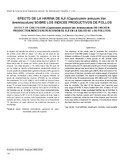Efecto de la harina de ají (Capsicumm annuum Var. bremisculum) sobre los índices productivos de pollo

Visualizar/
Data
2021Palabras Clave
Aditivos alimentarios, Ganancia de peso, Mortalidad, Pesos de órganosFood additives, Weight gain, Mortality, Organ weights
Metadatos
Mostrar registro completoResumo
El objetivo del estudio fue evaluar el comportamiento productivo
de pollitos Cobb 500 en etapa 1-21 días (d) de edad en las
condiciones andinas del Ecuador. Se emplearon un total de
315 pollos, con un d de edad, distribuidos en tres grupos de
105 animales cada uno: T1, Control (dieta basal sin aditivo); T2,
dieta basal más 10 partes por millón (ppm) de ají (Capsicumm
annuum Car. bremisculum) y T3, dieta basal más 50 ppm de
ají. Se utilizó un diseño completamente aleatorizado donde se
evaluó: grado de aceptabilidad, ganancia de peso (GP), ganancia
media diaria (GMD), conversión alimenticia (CA), ocurrencia
de diarreas, mortalidad y peso relativo de órganos linfoides. El
grado de aceptabilidad fue superior (P<0,05) en los animales
del tratamiento T3; la GP, GMD y CA (P>0,05) no variaron entre
tratamientos; la ocurrencia de diarrea fue menor (P<0,05) en el
grupo T3, en este mismo tratamiento (T3) no hubo mortalidad; el
tamaño del timo y la bolsa de Fabricio fue superior (P<0,05) en
los tratados con ají, de éstos el T3 tuvo mejor comportamiento.
Se concluye que el uso de la harina de ají en pollos de 1-21 d de
edad no mejora la GP ni la CA. El peso relativo de timo, bazo y
bolsa de Fabricio no variaron entre tratamientos, mientras que el
tamaño del timo y bolsa de Fabricio fue mejor en el tratamiento
T3. Asimismo, se logró disminuir los trastornos diarreicos y la
mortalidad.
Colecciones
Información Adicional
| Otros Títulos | Effect of Chili flour (Capsicumm annuum Var. bremisculum) on chicken production índices repercusión de ají en la salud de los pollitos |
| Correo Electrónico | jose.miranda@ucuenca.edu.e |
| ISSN | 0798-2259 |
| ISSN Electrónico | 2477-944X |
| Resumen en otro Idioma | The objective of the study was to evaluate the productive behavior of Cobb 500 chicks in stage 1-21 days (d) of age in the Andean conditions of Ecuador. A total of 315 one-d-old chickens were used, distributed in three groups of 105 animals each: T1, Control (basal diet without additive); T2, basal diet plus 10 parts per millions (ppm) of chili pepper (Capsicumm annuum var. Bremisculum) and T3, basal diet plus 50 ppm of chili. A completely randomized design was used where the degree of acceptability, weight gain (WG), mean daily gain (MDG), feed conversion (FC), occurrence of diarrhea, mortality and relative weight of lymphoid organs were evaluated. The degree of acceptability was higher (P<0.05) in the T3 treatment animals; WG, MDG and FC (P>0.05) did not vary between treatments; the occurrence of diarrhea was lower (P<0.05) in group T3, in this same treatment (T3) there was no mortality; the size of the thymus and Fabricio’s bag was larger (P<0.05) in those treated with chili, of these T3 had better performance. It was concluded that the use of Chili flour in chickens 1-21 d of age does not improve WG or FC. The relative weight of the thymus, spleen and Fabricio’s bursa did not vary between treatments, while the size of the thymus and Fabricio’s bursa was better in treatment T3. Likewise, it is possible to reduce diarrheal disorders and mortality. |
| Colación | 110-116 |
| País | Venezuela |
| Institución | Universidad del Zulia (LUZ) Universidad de Los Andes (ULA) |
| Publicación Electrónica | Revista Científica |
| Sección | Revista Científica: Artículos |





